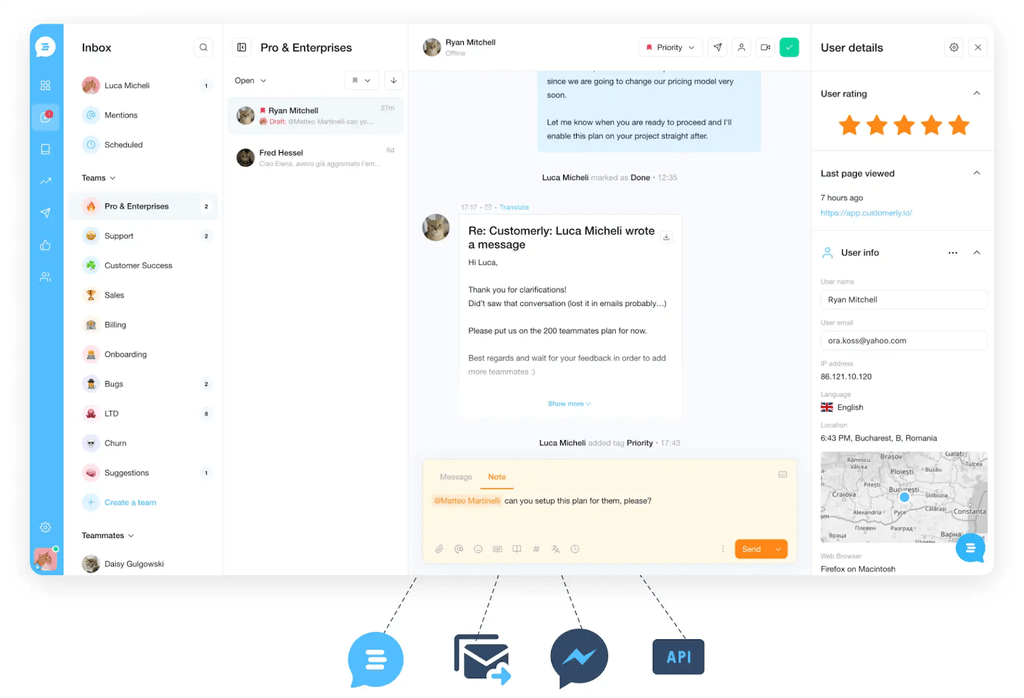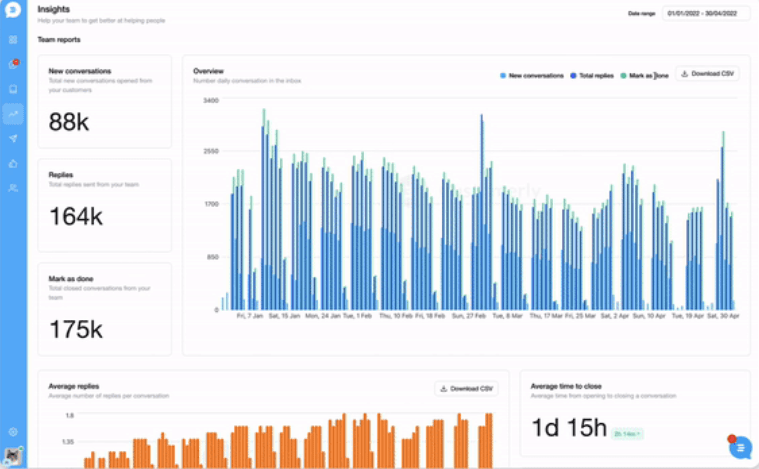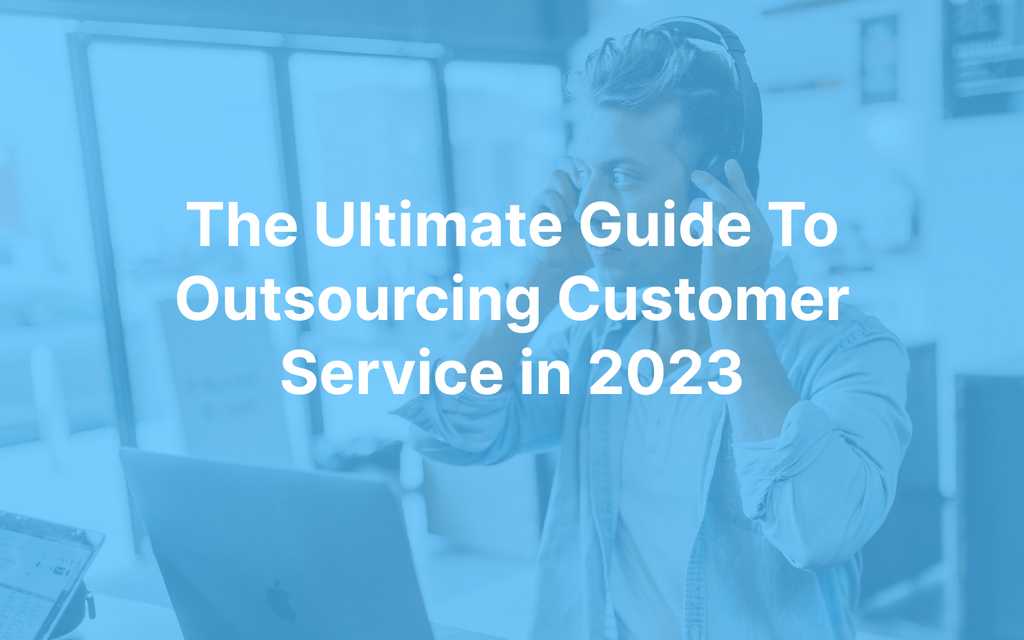Creating a great customer service experience for your customers is absolutely key. Service-based issues are at least 300% more likely to lead to churn than aaany other kind of issue—product, pricing, billing… these don’t come close.
But establishing a great customer service team or department is easier said than done. It takes experience, dedication, and upfront resources that many businesses can’t afford to part with.
That’s where outsourcing customer service comes in.
It’s an affordable way to access the expertise and skills you need to provide a great customer experience. In this Customerly guide, we’ll look at why you should outsource customer service, how it works, and tips for finding great providers.
Let’s get started.
What Is Outsourced Customer Service?
As you can probably tell from the name, outsourced customer service simply means working with a third-party provider to deliver some (or all) of your customer services—things like:
- Answering questions from customers
- Resolving customer issues and complaints
- Assisting with product returns or exchanges
- Educating customers on your products and services.
These third-party providers (known as CS BPOs) offer an alternative to in-house customer service teams and tools like Customerly.

Customerly empowers your team by centralizing live chats, support tickets, and emails into a single platform. CS BPOs handle tasks like call center services, technical support, and more. For instance, you can see how Tweethunter used Customerly in order to streamline its email support services.
While the former is usually a better option for smaller teams or businesses who field technical support requests (e.g., SaaS), CS BPOs offer a quick and easy solution that’s worth exploring.
Where Can I Find Customer Service Outsourcing Solutions?
- You can go through Clutch and similar review websites for agencies and outsourced customer support providers.
- Third-party providers like Outsource Accelerator, Foundever and Microsourcing could be great options depending on your niche.
- You can use LinkedIn to find providers from your direct network or after a bit of investigation.
- On another note, you can ask around. Direct referrals from your niche can be an effective way to find the right partner for your needs.
- Marketplaces like Upwork can help you find candidates, although the quality may be lacking.
- Networking events, conferences, and groups could also help you find great providers in your niche.
Why Should You Outsource Customer Services?
Lower Operation Costs
Outsourcing customer service can help reduce operational costs as you will be paying a third-party provider for their services rather than having to pay wages, benefits, and any other employer-related costs.
Access to Expertise & Tools
Outsourcing customer service gives you on-demand access to a team of highly trained customer service professionals. Plus, these providers will already have the tools needed to deliver their service—no need to shop around for the best solution.
Added Flexibility
Your business isn’t static—there are cycles of growth and downtime that come with changing customer service requirements. Working with a third-party provider makes it easier to respond to these changes—just add or remove customer service agents as needed for a more agile approach.
Grow Your Support Coverage
With an outsourced customer service provider, you can quickly expand your support coverage to multiple countries and languages. As you expand, you’ll also be able to benefit from the provider’s existing sales and customer service infrastructure which can reduce your costs.
What Is the Cost of Outsourcing Customer Service?
You probably don’t need us to tell you that there isn’t one single answer to this question. The best we can do is give you the average hourly cost to hire a customer service BPO in different regions (and countries) around the world.
Here’s the breakdown:
| Region or Country | Hourly Rate |
| North America | $20 to $30 |
| Western Europe | $40+ |
| Eastern Europe | $12 to $25 |
| Australia | $35 to $55 |
| Africa | $15 to $20 |
| South America | $8 to $18 |
| Asia | $8 to $14 |
| India | $6 to $10 |
As you can see, the cost varies quite a bit (over 160%, to be exact) depending on location. This is mainly due to how different the cost of living is in different countries around the world.
But location isn’t the only important factor—let’s quickly go over a few others.
Factors Affecting the Cost of Outsourcing Customer Service
- Agents and Hours: More agents and more hours will increase the price.
- Times of Operation: If you need customer service support outside of normal business hours, it will cost more.
- Platforms: Some vendors may charge extra for using additional platforms like Customerly and Zendesk.
- Channels: If you need to cover multiple channels like phone, email, chat, etc., then the cost will increase.
Outsourced vs. In-House Customer Service Costs
In-house customer service operations can get pretty expensive—the average cost of hiring (and supporting) your very own four-person customer service team for a year in the US is $259,955. If that figure seems high, consider the fact that you need to account for tools, hiring costs, and training in addition to salaries and benefits.
But what If you outsourced that team to a premium customer service provider in India? A four-person team working full-time (2,080 hours each) at $10 per hour would cost $83,200—for an impressive savings of $176,000 per year.
That differential is one of the main drivers behind the growing popularity of outsourcing customer service.
How To Find Great Customer Service Professionals
Not sure how to find high-quality reps to outsource your customer service operations to? That’s understandable—there’s a lot riding on the decision!
Here are some things to look for when vetting potential customer service professionals:
- Fluency: The languages you do business in are the most fundamental aspect of any customer service operation. Your agents need to be able to communicate effectively in whatever languages you’ve chosen to represent your brand without important details getting lost in translation.
- Testimonials: Like any professional service, it’s important to read reviews and get real-life testimonials from previous customers of any customer service provider before you commit. Sites like GoodFirms, Clutch, and Gartner are great for finding customer service providers.
- Incentives: Incentives are a valuable tool for rewarding reps and keeping them motivated. Be sure to ask any potential customer service provider what kind of incentives they offer their reps and how those incentivize loyal, long-term customer service.
- Call Monitoring Software: Call monitoring is an important aspect of any customer service operation. Be sure to ask about what kind of call monitoring technology your provider uses, and make sure it gives you the insights you need into customer service performance.
- Test Calls: Last but certainly not least, make sure you do some test calls with any potential provider to get a better understanding of their customer service performance.
6 Best Practices To Follow When Outsourcing Customer Service
1. Establish Your Motivation & Requirements
Before you begin looking for a customer service provider, it’s important to understand why you are outsourcing in the first place. Is it to reduce costs? Increase efficiency? Provide better customer service?
And on a similar note, think about requirements and dealbreakers. Do you want to use a certain customer service tool? Do you need customer service agents to be available 24/7?
Having this information makes it a ton easier to find the right customer service provider. It allows you to quickly zero in on relevant information—whether it’s on landing pages, review sites, or marketing materials.
2. Look for Partners
The distinction between partners and vendors is more than just a buzzword.
Vendors that don’t have a vested investment in your success can only do so much. Partners that have a stake in the success of your customer service operations will be more motivated to help you reach your goals.
It can be difficult to spot the difference in practice. There aren’t any hard-and-fast rules here, but partners will generally do the following:
- Take the time to get to know your company before closing a deal
- Make process transparency a priority
- Practice excellent, proactive communication
- Publically celebrate client success stories (e.g., case studies)
3. Take Charge of Training & Quality Assurance
The provider you partner with will probably have a process in place for gathering information about your business and training reps. Many will even have great processes.
You need to play an active role in the process—especially if your product or business is difficult for outsiders to understand.
In addition to supplying terms of service, user manuals, and other materials for reps to learn, consider setting up a “checklist” of detailed steps they need to know before getting on the phone.
4. Consider Offshore vs. Onshore Customer Service Providers
Think about whether you’d prefer to work with an offshore or onshore customer service provider.
Depending on your location, offshore providers may offer lower costs. But the cost isn’t the only consideration here—you also need to think about fluency, hours of operation, and in some cases, regulations.
5. Measure the Success of Your Customer Service Strategy
You need to be measuring the success of your customer service strategy. Set baselines for key metrics and track your progress to make improvements, and keep your outsourced customer service team on track.
Not sure what to track? Here are some common customer service metrics (along with benchmarks):
- Response Time: This will vary by channel—tickets (less than 24 hours), live chat (less than 1.5 minutes), and phone (less than 3 minutes).
- First Contact Resolution Rate: Roughly 65% or higher (depending on your industry.
- Average Handle Time (AHT): The multi-industry average is 3 minutes and 18 seconds.
- Net Promoter Score (NPS): Aim for 70 or higher.
Customerly makes it easy to keep tabs on all of these metrics (and more) through interactive dashboards and reports for agents, channels, and teams. That way, you can always make sure that your customer service initiatives are meeting your goals.

Plus, we offer real-time NPS tracking and intelligent survey options so you can keep your finger on the pulse of customer opinion.
6. Hold Regular Meetings and Review Discussions
Once you’ve started generating data, make sure you’re scheduling regular meetings with your CS BPO to talk about successes, roadblocks, and areas for improvement. Aligning your team on what’s working and what needs to be revisited should be an ongoing process.
During these meetings, make sure you also update the team about upcoming developments that might affect support requests and responses—things like:
- Updates
- Planned maintenance
- New features & products
Conclusion
Done well, outsourced customer service can be an effective, cost-efficient way to give your customers the excellent support they expect (and deserve).
At Customerly, we empower businesses to deliver remarkable customer service, maximize conversions, and improve retention. Our platform brings your helpdesk, CRM, and marketing automation tools under one roof so that you have the context needed to wow your customers.
Get started with a 14-day free trial and see what Customerly can do.
Start your 14-day free trial
Empower businesses to deliver remarkable customer service


